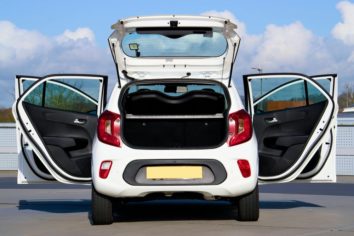Plugg-in hybrid SUVs: The Best of Both Worlds for the Car Enthusiast

Introduction
Plug-in hybrid SUVs have gained significant popularity in recent years, and for good reason. These vehicles combine the best of both worlds, offering the efficiency and environmental benefits of hybrid technology, along with the versatility and practicality of an SUV. In this comprehensive article, we will provide an in-depth overview of plug-in hybrid SUVs, exploring what they are, the different types available, popular models, and quantitative measurements. We will also discuss the key factors that differentiate various plug-in hybrid SUVs, their historical advantages and disadvantages, and the decisive factors that car enthusiasts consider when purchasing a vehicle.
What are plug-in hybrid SUVs?

Plug-in hybrid SUVs, often referred to as PHEV SUVs, are vehicles that combine an electric motor, a conventional internal combustion engine, and a battery pack. Unlike conventional hybrid vehicles, plug-in hybrid SUVs can be charged externally, allowing for extended electric-only driving range. This charging capability eliminates range anxiety, making these vehicles more practical for daily commutes, while still providing the flexibility of a traditional internal combustion engine for longer journeys.
Exploring the different types and popular models
When it comes to plug-in hybrid SUVs, there are various types available, each with its unique characteristics and features. Some PHEV SUVs prioritize all-electric range, offering larger batteries and optimized electric motors, while others focus on blending electric and gasoline power for enhanced performance. Popular models in the plug-in hybrid SUV segment include the Mitsubishi Outlander PHEV, Volvo XC60 Recharge, and BMW X5 xDrive45e, each offering its own combination of efficiency, power, and luxury.
Quantitative measurements of plug-in hybrid SUVs
To better understand the capabilities of plug-in hybrid SUVs, it is essential to analyze their quantitative measurements. Some key metrics to consider include electric-only range, fuel efficiency, power output, and charging time. For example, the Mitsubishi Outlander PHEV offers an impressive electric-only range of up to 22 miles, while the BMW X5 xDrive45e delivers a powerful 389 horsepower. Furthermore, advancements in charging infrastructure have significantly reduced charging times, with some models capable of achieving an 80% charge in as little as 30 minutes.
Differentiating factors among plug-in hybrid SUVs
While plug-in hybrid SUVs share many similarities, there are several factors that differentiate them from one another. These factors include the size of the battery pack, level of electric motor integration, available driving modes, and overall driving dynamics. Some PHEV SUVs prioritize electric driving, utilizing larger battery packs and offering more EV-specific features, while others prioritize performance by blending electric and gasoline power. Understanding these distinctions can help buyers choose a vehicle that aligns with their specific needs and preferences.
Historical advantages and disadvantages
Throughout the years, plug-in hybrid SUVs have evolved, bringing both advantages and disadvantages. In their early stages, limited all-electric range and hefty price tags were common drawbacks. However, advancements in battery technology have substantially increased electric range, and prices have become more competitive. Moreover, plug-in hybrid SUVs offer the environmental benefits of reduced emissions and improved fuel efficiency, making them an attractive option for eco-conscious drivers.
Decisive factors for car enthusiasts
When it comes to purchasing a vehicle, car enthusiasts consider various factors to ensure they make an informed decision. Some key factors include performance, driving experience, technology features, safety, and overall value for money. Plug-in hybrid SUVs cater to these needs by offering both power and efficiency, advanced infotainment systems, cutting-edge safety technologies, and a blend of luxury and practicality.
Conclusion
In conclusion, plug-in hybrid SUVs provide an excellent solution for those seeking the benefits of hybrid technology and the practicality of an SUV. With various types available, each with unique characteristics, prospective buyers have a wide range of options to choose from. Quantitative measurements such as electric range, fuel efficiency, and power output further demonstrate the capabilities of these vehicles. By understanding the differences among different models, the historical advantages and disadvantages, and the crucial deciding factors for car enthusiasts, buyers can make an informed choice when considering a plug-in hybrid SUV.
FAQ
What is a plug-in hybrid SUV?
What are some popular plug-in hybrid SUV models?
What are the decisive factors for car enthusiasts when choosing a plug-in hybrid SUV?
Fler nyheter
Elbilsladdare i Stockholm: Navigera i framtidens fordonslandskap
Introduction Plug-in hybrid SUVs have gained significant popularity in recent years, and for good reason. These vehicles combine the best of both worlds, offering the efficiency and environmental benefits of hybrid technology, along with the versatil...
Maja Bergman Lindberg
23 juni 2024
Begagnade bilar i Vimmerby – ett smartare val
Introduction Plug-in hybrid SUVs have gained significant popularity in recent years, and for good reason. These vehicles combine the best of both worlds, offering the efficiency and environmental benefits of hybrid technology, along with the versatil...
Lotta Alberius
20 juni 2024
Utforska Göteborgs naturliga skönhet på en mountainbike
Introduction Plug-in hybrid SUVs have gained significant popularity in recent years, and for good reason. These vehicles combine the best of both worlds, offering the efficiency and environmental benefits of hybrid technology, along with the versatil...
Lotta Alberius
17 juni 2024
Att köpa gardiner i Göteborg: En guide till ditt fönsterdraperi
Introduction Plug-in hybrid SUVs have gained significant popularity in recent years, and for good reason. These vehicles combine the best of both worlds, offering the efficiency and environmental benefits of hybrid technology, along with the versatil...
Maja Bergman Lindberg
09 juni 2024











